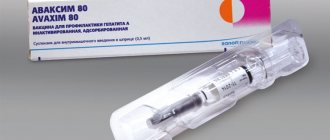Varilrix - chickenpox vaccine
Live attenuated vaccine
Manufacturer: GlaxoSmithKline Biologicals, Belgium.
Protects against viral disease: chicken pox.
It is tried on: in children from the age of 12 months who have not had chickenpox and have not been vaccinated previously, as well as in adults.
Not included in the national vaccination calendar.
IMPORTANT: vaccinations with the Varilrix vaccine are not carried out in clinics
Varilrix price
| Service | Price | Note |
| Varilrix, Belgium | 2100 | from 12 months |
Chickenpox is a highly contagious infectious disease caused by a virus from the herpes virus family. The varicella zoster virus, when it first enters the human body, causes the picture of “chickenpox”. The chickenpox virus “settles” in the nerve plexuses for life. And when the immune system weakens (usually in old age or with severe concomitant diseases), it becomes more active, causing herpes zoster. In childhood, the disease often progresses favorably, but in adults it is much more difficult to tolerate, and bacterial complications are more often observed. The varicella zoster virus poses a particular danger to pregnant women and the fetus.
Release form
Varilrix is a live attenuated vaccine based on attenuated human varicella zoster virus (Varicella zoster) cells with specific activity. Each package contains:
- one syringe with solvent;
- two needles for mixing and preparing the vaccine;
- bottle with powdered lyophilisate.
Intended for intramuscular subcutaneous administration. The vaccine, in addition to the main active ingredient, contains auxiliary components (lactose, amino acids, water for injection, sorbitol).
Emergency prevention
Vaccination is carried out once with 1 dose of vaccine (0.5 ml) during the first 96 hours after contact (preferably within the first 72 hours). If the disease does not develop, then re-vaccination is carried out after 6-8 weeks.
Clinical studies have shown the high effectiveness of the Varilrix® vaccine. The rate of seroconversion (development of immunity) in healthy children aged 12 months to 12 years inclusive, determined 6 weeks after vaccination, exceeded 98% and persisted for at least 7 years after vaccination.
The seroconversion rate measured in children aged 13 years after two doses of vaccination was 100% and was maintained for at least 1 year.
Clinical studies have shown that the majority of vaccinated people who were subsequently in contact with sick people are either not susceptible to infection or experience a much milder form of the disease (fewer rashes, no fever).
To ensure that the seroconversion rate is as high as possible, since the end of 2012, the Varilrix® vaccine has been used with booster vaccination at all ages, which prevents the occurrence of so-called “breakthrough chickenpox” (an outbreak of chickenpox in vaccinated children).
VARILRIX - vaccine for the prevention of chickenpox (VARILRIX)
GlaxoSmithKline, Belgium
Release form: 1 bottle / 1 dose 0.5 ml + syringe with solvent.
Vaccination schedule: Children 12 months. - 13 years - once 0.5 ml. Over 13 years old - 0.5 ml twice with an interval between administrations of 6-10 weeks.
INSTRUCTIONS FOR USE VARILRIX vaccine for the prevention of chickenpox (VARILRIX)
COMPOSITION AND FORM OF RELEASE: lyophile. por. d/in. fl. 1 dose, with solution. in amp. 0.5 ml, No. 1 163.52 UAH. lyophil. por. d/in. fl. 1 dose, with solution. in amp. 0.5 ml, No. 5, No. 25, No. 100 lyophil. por. d/in. fl. 1 dose, with solution. in a syringe 0.5 ml, No. 1, No. 5, No. 25, No. 100 It is a lyophilized preparation of a live attenuated (weakened) varicella zoster virus (Oka strain), obtained by reproducing the virus in a culture of human diploid cells MRC-5. Varilrix meets WHO requirements for biological agents and vaccines against varicella. A 0.5 ml dose of vaccine (after dissolution) contains at least 1033 plaque-forming units of varicella zoster virus. No. 309/07-300200000 from 03/13/2007 to 03/13/2012 INDICATIONS: Healthy individuals The vaccine is indicated for active immunization against chickenpox in healthy individuals (starting from 9 months of age). Persons who are in close contact with patients at high risk of disease should be vaccinated to reduce the risk of transmission of the pathogen to such patients. These include parents and close relatives of high-risk patients, medical (including paramedical) personnel and other persons who are in close contact with patients with chickenpox or with patients at high risk of the disease. Patients at high risk of chickenpox Patients with leukemia receiving immunosuppressive therapy (including corticosteroid therapy), patients with malignant tumors or severe chronic diseases (CKD, autoimmune diseases, collagenosis, asthma), as well as persons who are planning organ transplantation, belong to a high-risk group of the disease and are prone to severe chickenpox. Such patients are indicated for immunization with the vaccine to reduce the risk of chickenpox. Given the limited clinical trial data for the Varilrix vaccine, immunization of patients at risk should be prescribed taking into account the following precautions: when vaccinating patients in the acute phase of leukemia, maintenance chemotherapy should be discontinued 1 week before and for 1 week after immunization. Patients prescribed radiotherapy are not recommended to be vaccinated throughout the entire treatment period. It is desirable that the number of lymphocytes in the peripheral blood is at least 1200/mm3, and that there are no other manifestations of immunodeficiency. APPLICATION: 0.5 ml vaccine dose (after dissolution) contains 1 immunizing dose. Children from 9 months to 12 years of age inclusively are prescribed 1 dose of the vaccine (0.5 ml), children aged 13 years and older - 2 doses with an interval of at least 6 weeks between them. Additional doses of the vaccine may be required to vaccinate high-risk patients. The Varilrix vaccine is intended for subcutaneous administration. The recommended injection site is the shoulder area at the site of the deltoid muscle projection. Due to slight fluctuations in pH, the color of the vaccine ready for administration may range from pink to red. Before injection, the diluent and the dissolved vaccine must be carefully visually assessed for the presence of any foreign matter and/or deviations in physical characteristics. If deviations are detected, the solvent or vaccine is not used. Varilrix is dissolved by adding the supplied solvent to the vial containing the dry lyophilized powder. After adding the solvent to the powder, the mixture must be shaken until the powder is completely dissolved. When treating the injection site, you should wait until the alcohol or other antiseptic has completely dried on the surface of the skin before administering the vaccine, as they may cause partial inactivation of the virus. The vaccine must be administered immediately after dilution. Intradermal and intravascular administration of Varilrix is contraindicated. CONTRAINDICATIONS: Varilrix vaccination is contraindicated in individuals with a total peripheral blood lymphocyte count ≤1200/mm3 or other manifestations of immunodeficiency; persons with known systemic hypersensitivity to neomycin (a history of contact dermatitis due to the action of neomycin is not a contraindication to vaccination); during pregnancy. Moreover, pregnancy should be avoided for 3 months after vaccination. SIDE EFFECTS: Healthy Individuals More than 7,900 individuals participated in clinical studies examining the reactogenicity of the vaccine. Children (ages 9 months to 12 years) The most common side effects were reactions at the injection site (moderate pain, flushing, swelling). The following side effects were also noted: general reactions can be in the form of fever - body temperature from 37.5 °C (under the arms)/38 °C (rectally) to 39 °C (under the arms)/39.5 °C (rectally) . There have been case reports of a papulovesicular rash (similar to the chickenpox rash). In a double-blind, placebo-controlled study with a 4-week follow-up period that included 513 children aged 12–30 months, there were no statistically significant differences in the pattern or frequency of clinical events in those receiving the vaccine or placebo. Adolescents (≥13 years) and adults The most common side effects were injection site reactions (moderate pain, flushing, swelling). The following side effects have also been reported: General reactions may occur in the form of fever with a body temperature of 37.5 °C (armpit) / 38 °C (rectal) to 39 °C (armpit) / 39.5 °C (rectal) ). There have been reports of a papulovesicular rash (similar to the chickenpox rash) in approximately 5% of individuals within 6 weeks of vaccination. In general, reactogenicity after the second dose was no higher than after the first dose. In a double-blind, placebo-controlled study of 513 children aged 12–30 months, there was no statistically significant difference in the pattern or incidence of fever and skin rashes in children who received the vaccine or placebo. There was no difference between reactogenicity in initially seropositive and seronegative individuals. High-risk patients There is limited systematic clinical trial data for this patient group. However, reactions associated with the use of the vaccine (mainly papulovesicular rash and fever) were generally mild. As in healthy individuals, hyperemia, swelling and pain at the injection site were mild and quickly passing (from several days to several weeks). Symptoms are more often observed in patients with leukemia receiving immunosuppressive therapy who are in the maintenance stage of chemotherapy. The appearance of a rash does not affect the clinical condition of patients. There is no evidence that immunization can negatively affect the course of the disease. SPECIAL INSTRUCTIONS: As with other vaccines, immunization with Varilrix should be delayed in persons with acute illness accompanied by fever. However, the presence of minor manifestations of infection is not a contraindication for vaccination. As with all other injectable vaccines, immunization must be supervised by medical personnel. Necessary precautions should be taken in the event of a rare anaphylactic reaction following vaccine administration. As with other varicella vaccines, cases of varicella have been reported in patients pre-immunized with Varilrix. These cases were rare, and fever and other clinical symptoms of the disease were less severe than in unvaccinated patients. It has been shown that transmission of the vaccine virus (Oka strain) through contact of vaccinated individuals with seronegative individuals is very rare. A moderate rash in healthy contacts indicates that the virus remains weakened (attenuated) after transmission through people carrying the virus. During pregnancy and breastfeeding, the use of Varilrix is contraindicated, since the effect on fetal development is unknown. In addition, pregnancy should be avoided for 3 months after vaccination. There are no data regarding the use of the vaccine in breastfeeding women. When carrying out immunization on the territory of Ukraine, regarding immunization regimens, contraindications and interactions with other drugs, one should be guided by the current orders of the Ministry of Health of Ukraine. INTERACTIONS: In persons who have received immunoglobulins or who have undergone blood transfusions, vaccination should be delayed for at least 3 months due to the passive acquisition of antibodies to the varicella zoster virus. The use of salicylates should be avoided for 6 weeks after varicella vaccination, as Reye's syndrome has been reported following the use of salicylates during spontaneous varicella zoster virus infection. In healthy individuals, Varilrix can be given at the same time as any other vaccine. Different injectable vaccines should always be given at different sites. Inactivated vaccines can be administered at any time relative to the administration of the given vaccine. If a vaccine containing measles virus is not administered at the same time as Varilrix, an interval of at least 1 month is recommended, as it is believed that measles vaccination may cause a short-term suppression of the cellular component of the immune response. In high-risk patients, Varilrix should not be administered concomitantly with other live attenuated vaccines. Inactivated vaccines can be used at any time in relation to the administration of this vaccine. Different injectable vaccines should always be given at different sites. Varilrix cannot be mixed with other vaccines in the same syringe. STORAGE CONDITIONS: The shelf life of lyophilized Varilrix vaccine in the refrigerator at a temperature of 2–8 °C is 24 months. The expiration date of the vaccine is indicated on the label and packaging. Lyophilized vaccine is not affected by freezing. The solvent should be stored in the refrigerator or at room temperature (not higher than 25 ° C). The vaccine must be administered immediately after dilution. Refrigerated trucks should be used to transport the vaccine, especially in hot climates. CHARACTERISTICS: The mechanism of action of the Varilrix vaccine is that in susceptible individuals the vaccine causes a weakened, clinically asymptomatic form of chickenpox. A certain level of protection can be achieved by immunization within 72 hours of exposure to a person with chickenpox. Healthy individuals In children aged 9 months to 12 years, the overall seroconversion rate within 6 weeks after vaccination was 98%. In children immunized at 12–15 months of age, antibodies persisted for at least 7 years after vaccination. In persons aged 13 years and older, the seroconversion rate was 100% 6 weeks after the second dose. One year after vaccination, all individuals remained seropositive. In an efficacy study in children 10 to 30 months of age, protective efficacy was 100% compared with normal clinical varicella cases (≥30 vesicles). Compared with mild cases of varicella (mild with at least 1 vesicle or papule present), the protective efficacy was 88%. However, the cases were mild (median number of vesicles, 1; no fever reported). Patients at high risk for varicella In patients at high risk for varicella, the overall seroconversion rate was greater than 80%. In such patients, it is advisable to periodically examine the level of antibodies to the varicella zoster virus in order to determine those in whom revaccination is advisable.
Using Varilrix in combination with other vaccines
The Varilrix® vaccine can be administered simultaneously with all drugs from the national preventive vaccination calendar on the same day, in different parts of the body, with the exception of the BCG vaccine and the rabies vaccine (rabies vaccination).
The use of the Varilrix® vaccine in combination with other vaccinations does not affect their immunogenicity (ability to develop immunity). Tolerability of vaccines does not deteriorate, and the number of adverse reactions does not increase.
Administering several vaccines on the same day does not place an excessive burden on the immune system.
Administration of the Varilrix® vaccine is possible no earlier than 3 months after the administration of immunoglobulins or after blood transfusion.
Adverse reactions
Reactions to the Varilrix® vaccine are rare and most often easily tolerated. They are divided into local and general.
Local reactions: pain and redness at the injection site.
General reactions: increased body temperature to subfebrile levels, lymphadenopathy (swelling of the lymph nodes), weakness, malaise. A rash similar to chickenpox may appear. The rash is not abundant and rarely develops into blisters.
Most often, such reactions do not require special treatment; symptomatic therapy is carried out.
On average, the reactogenicity of the vaccine upon administration of the second dose (re-vaccination) does not exceed the reactogenicity of the first dose. There were also no differences in the safety profile of the vaccine between people with and without immunity to chickenpox.
Contraindications for use
- primary or acquired immunodeficiency (developed as a result of leukemia, lymphoma, clinical manifestations of HIV infection, use of immunosuppressants, including high-dose corticosteroid therapy), as well as in the presence of other signs of cellular immunodeficiency;
- acute infectious and non-infectious diseases, exacerbation of chronic diseases are temporary contraindications for vaccinations; for mild ARVI and acute intestinal diseases, vaccinations are carried out immediately after the temperature has normalized;
- pregnancy or planned pregnancy within 3 months;
- lactation period (breastfeeding);
- hypersensitivity to any component of the vaccine (including neomycin);
- symptoms of hypersensitivity to previous administration of the Varilrix® vaccine.
The vaccine is contraindicated for use during pregnancy or planned pregnancy (within 3 months) and during breastfeeding.
When should the Varilrix vaccine not be given?
- if the test results do not comply with the standards
- at elevated temperature in a child
- in case of intolerance to the components contained in the Varilrix vaccine
- during exacerbation of chronic diseases
- in other cases mentioned by the pediatrician before vaccination
Additional Information
Is it possible to buy Varilrix from us or where to buy Varilrix in Moscow?
Medical and “Our Children” do not sell the Varilrix vaccine, we vaccinate.
Where to get the Varilrix vaccination in Moscow?
You can get the Varilrix vaccination in medical and “Our Children”, the Varilrix vaccine is available. Vaccination requires a mandatory examination before vaccination, the vaccination itself and observation after vaccination.
Call us, we will tell you everything in more detail
PricesSpecialistsSign upContacts
| Name of service | |
| Reception | |
| Examination by a doctor before vaccination | 1600 |
| Examination by a doctor before tuberculin diagnostics | 800 |
| PREVENTION OF CHICKENPOX | |
| Varilrix - vaccination against chickenpox - 5,000 rubles. | 2500 |
Call us, we will tell you everything in more detail
additional information
For emergency prevention, the vaccine can be used in the first 96 hours. Time is counted not from the moment the patient is diagnosed, but from the moment of last contact with the patient with chickenpox.
The Varilrix® vaccine protects only against chickenpox and does not protect against other diseases accompanied by skin lesions and other diseases caused by viruses of the herpes family.
Women of childbearing age are advised to protect themselves from pregnancy for 1 month before vaccination and 2 months after vaccination.
Vacation conditions
The vaccine is available with a doctor's prescription. The cost of the drug in Moscow depends on the dosage. For medical institutions, special packages of 100 ampoules are produced for mass vaccination in the clinic. You can check the price by calling the center's contact number.
| Immunoprophylaxis | Against infections | Price |
| "Varilrix" (Belgium) | chicken pox | 5,000 rub. 3500 Promotion! |
| The cost of examination before vaccination is 800 rubles. | ||
*Preliminary inspection is paid separately.
How is vaccination carried out?
Vaccination is carried out in a vaccination room, in compliance with all sanitary requirements. All drugs are certified. A certificate for the drug is provided upon request.
Without reminders, before vaccination, the medical worker must show the drug and the expiration date of the vaccine.
Only sterile and disposable instruments are used. The vaccination must be carried out using disposable medical gloves.
On the day of vaccination, the child is examined by a pediatrician and the temperature is measured. In the absence of contraindications, vaccination is carried out. Information about the vaccination performed is entered into the card, vaccination certificate, and detailed recommendations for caring for the child in the post-vaccination period are given.
Before vaccination, the doctor will answer all your questions. Be sure to bring information about previous vaccinations to your appointment!
Please note that vaccination of a child, Mantoux test, Diaskintest can only be carried out in the presence of parents or legal representatives of the child (guardians), or if the accompanying person has a NOTARIZED power of attorney to carry out the manipulation (indicating the drug planned for administration) . Otherwise, vaccination will be denied. We comply with the laws of the Russian Federation.
Only here!




